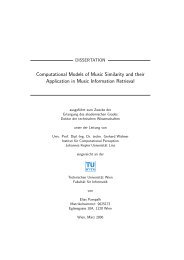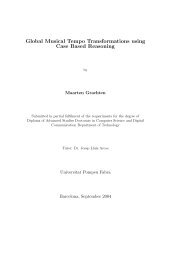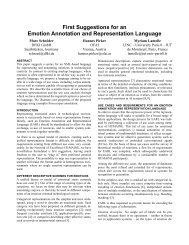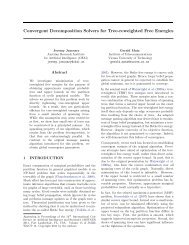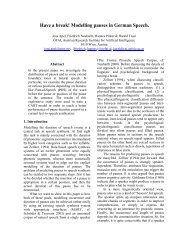A HYBRID MODEL OF REASONING BY ANALOGY
A HYBRID MODEL OF REASONING BY ANALOGY
A HYBRID MODEL OF REASONING BY ANALOGY
You also want an ePaper? Increase the reach of your titles
YUMPU automatically turns print PDFs into web optimized ePapers that Google loves.
4.9. Learning<br />
There are two main ways of learning in this architecture: by constructing nodes and by adjusting<br />
links.<br />
Node construction actually consists of two steps: generation of a new node and adjusting and<br />
interpretation of its links. It is possible to start with an uninterpreted link (an a-link) and, after it<br />
has been strengthened to its maximum weight of 1, to give it some interpretation (usually as a partof<br />
relation) and at this moment to make it a part of the description frame corresponding to this<br />
node, i.e. one of its slots.<br />
There are also some processes which directly construct new temporary nodes (e.g. the node<br />
constructor process discussed in section 5.2.) some of which can later become permanent.<br />
Link weights are changed according to a sort of competitive learning. The only node whose links<br />
weights are changed is the focus. The strengthening of the links connecting the focus to its<br />
neighbors is proportional to the activities of the neighbors. This is done by computing the mean<br />
activity of all neighboring nodes and changing the links beginning at the focus according to the<br />
formula:<br />
w focus,i<br />
= ß(a i<br />
(t) - a mean<br />
(t)).<br />
The normalization of the weights of the outcoming links (so that ∑ j<br />
w ij<br />
= 1) is done each time they<br />
are used (i.e. the actual link weights are dynamically computed). When the weight of a link reaches<br />
the maximum level of 1, then it is not changed any more.<br />
New associative links (a-links) are always built between the input nodes, the goal nodes and the<br />
focus, as well as between the input nodes and between the goal nodes themselves.<br />
5. COMPUTATIONAL <strong>MODEL</strong> <strong>OF</strong> ANALOGICAL PROBLEM SOLVING<br />
This section treats in greater detail the process components of analogical reasoning; how the<br />
mechanisms of the proposed cognitive architecture contribute to the model of reasoning by<br />
analogy; and how the model explains the empirical facts.<br />
5.1. The Retrieval Process<br />
5.1.1. Mechanisms of Retrieval<br />
"To use an analogy, gaining access to LTM, is a bit like fishing: the learner<br />
can bait the hook - that is, set up the working memory probe - as he or she<br />
chooses, but once the line is thrown into the water it is impossible to predict<br />
exactly which fish will bite."<br />
D. Gentner (1989)<br />
There are two mechanisms of retrieval in AMBR: automatic and strategic.<br />
Automatic re trieval is the process responsible for keeping the memory state of the reasoner in<br />
correspondence with the current context. It follows the development of the context and reflects its<br />
changes by continuously recomputing the associative relevance of all memory elements, to be used<br />
by the other symbolic processes. It is performed by a process of automatic spreading activation<br />
with the underlying assumption that the activity of a node reflects its associative relevance to the




